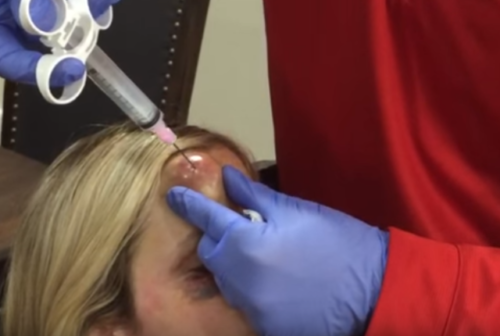Brain On Legalized Marijuana, Cannabis, THC
Medicine is a profession which responds to human misery by discovery and the innovation of solutions. We’re “hampered” in some ways, of course, by ethical considerations for how we treat humans.
For example we don’t go around concussing peoples heads, removing their limbs with explosions or injecting poisons to see how they damage their developing brains. For that we must wait until people do that to themselves or others – like in war, football… and now open, legalized marijuana use!
Actually an aspiration of large hematoma
[used for effect, sorry!]
I’ve already described how surgeons are recognizing lower death tolls of wounded soldiers and the exploding knowledge about footballer’s brain trauma.
Today I need to describe the only very recent understanding about developing brains we’ve been given by… you guessed it, the terribly “un-enlightened” states who have legalized marijuana for recreational use.
Hot Off The Press Brain Research
Now here’s the explanation in the form of recent research reported in the Journal of the American Medical Association (JAMA Psychiatry) this March (2016). Researchers published an exhaustive review of what we know and don’t know about marijuana use, specifically to talk some sense (“inform the debate”) into “agenda motivated” legislators and so-called “lobbyists” for legalized marijuana.
Structural Scaffolding
Have you recently learned that scientists can now actually grow a replacement ear out of a person’s stem cells? They do it by first carving an apple to replicate the needed ear then using chemicals to tenderly remove all the actual living apple cells which leaves behind each cell’s outer “shell” – a sort of “scaffold” of where cells once were. Then, they very carefully introduce human stem cells into the fluid which seem to recognize the organization and grow into an ear using the “apple scaffold” as a “blueprint.”
It’s sort of like honeybees using preformed honeycomb provided by the bee-keeper instead of needing to “freelance” on their own.
In the brain, the billions of neuron cells “normally” form channels of interconnections based on genetics; and, what we are finding now, they then adapt to learning and experience in order to create a “scaffold” of inter-connectivity which can then be used to solve future problems.
It’s this “scaffold” of neural abilities and connections which assist in future life-functioning and success; and, which can be damaged or shot-to-crap by drugs.
Powerful Disruptors

Nerves work by “firing” to stimulate other nerves (to which they have formed a link) so the will then “fire” in turn. A nerve may be connected to one or many other nerves and they in turn can connect to still more nerves in a chain to form a “cascade” of nerves all firing in turn.
Connections between nerves change over time. Paths are added and some are pruned, based on numbers of firings, successful outcomes, life experiences and who knows what else.
Drugs screw all that up! The newly published review warns: “Drugs are powerful disruptors of brain programming because they can directly interfere with the process of neural pruning and interregional brain connectivity.”
What we’ve learned is that young human brains undergo a fairly protracted period of “programming” which doesn’t end until some as yet undetermined time into early adulthood (i.e. long after puberty’s outward signs have finished.) Everything a child and adolescent does or is exposed to can affect the eventual architecture and network connectivity of the brain.
So what do drugs, including marijuana, do? In the short term: “negatively effect academic performance”. In the long term: “impair behavioral adaptability, mental health and even life ‘trajectory’!”
Neuropsychological Decline
Adolescents are greatly more vulnerable to adverse effects of cannabis, and show greater neuro-psychological impairment than adults.
Many studies, now replicated, show greater neuropsychological decline between 13 and 38 years of age when cannabis use was begun before adulthood – which is not seen when marijuana use begun in adulthood.
There is clear evidence of actual structural alterations in several areas of the brain when exposed to cannabis – along with other drugs including alcohol.
Functional MRI studies show neural activity alterations during memory tasks in cannabis users which cause them poorer scores due to inefficient processing.
Cannabis ‘Amotivational’ Syndrome

The Latin prefix “A” before a word means: “without.” “Amotivation” therefore means “without motivation” and it is seen so regularly when the use of cannabis is begun that it is used to help diagnose drug use in teens.
Actual research findings have led to defining the Cannabis Amotivational Syndrome distinguished by apathy and difficulty with concentration and obviously leading to underachievement in education.
THC, the active ingredient in cannabis is known to disrupt reward-based learning and further adds to educational success.
A boy once defended himself by telling me “naw, it has nothing to do with school, I’m still just as smart. I just would rather hang” (with my friends and do drugs). Even if it’s not THE cause – school is in the toilet at the most critical time of the child’s life.
Studies are underway now to ascertain if there is a dose related response between amotivation and THC use.
Cannabis and Psychosis
We KNOW that cannabis with a high THC level can trigger psychiatric disorders, notably frank psychosis and schizophrenia, even if we don’t yet understand the mechanism, extent or other things about it.
The only real debate in this area is whether the cannabis is merely unmasking a person’s tendency for the disease. The consensus is that cannabis use in those at risk for schizophrenia can trigger the disease and exacerbate its course.
We commonly and consistently see, in practice, that the use of cannabis and schizophrenia are associated even where cannabis use comes first before the patient develops schizophrenia; AND, more schizophrenia in those who start cannabis use in adolescence and/or use high-potency THC.
The statistics show cannabis doubling the risk and accounting for 8-14 percent of schizophrenia cases. Additionally, frequent cannabis use or use of high-potency THC increases the risk by 600 percent!

The argument, even if legitimate, that we don’t know how great a part the cannabis plays in those “predisposed” to schizophrenia is a moot point entirely. We know it makes it worse and neither the teen (or legislators acting like teens) have any way of knowing who is truly “predisposed.”
Key Questions
Here is where my viewpoint and the researchers report start to deviate a bit.
I DO AGREE that there remain some key questions to be answered. I DO AGREE it would be nice to know “how much cannabis use is too much?” BUT, I add “does it really matter?”
And I do agree with their second question: “At what age is cannabis use most harmful?” BUT NOT with the idea that legislators can mandate a minimum age; rather, due to the great possibility that there are probably negative effects in older individuals as well as we all develop brain-plasticity and cognitive issues with age.
Marijuana is clearly NOT A BENIGN drug!
Legislator-Caused Mental Illness
The drug pushers, i.e. those advocating drug use in the open, are trying to distance themselves (and obscure us) from the true name of the issue: drug abuse; by masquerading under the obscure moniker: “normalization.” Deliberately designed to minimize our opposition.
What legislators and parents need to understand is that the morbidity (damage) and mortality (death) from LEGAL drugs is MUCH GREATER than that for ILLEGAL drugs because their legal status makes them MORE ACCESSIBLE and assures that a greater percentage of the population is regularly exposed to them.
This “so-called normalization,” legalize-drug-abuse movement presses ever onward WITH COMPLETE DISREGARD FOR THE EVIDENCE of marijuana’s negative and health consequences – largely due to hidden agendas and extreme financial bias.
– – 0 – –
“This is not a problem that is specific to marijuana… Young brains and drugs shouldn’t mix. Period.”
National Institute on Drug Abuse (NIDA)
Perhaps you’d like to read the full articles? Here you are.
[JAMA Psychiatry. 2016;73:292-297. Abstract]

